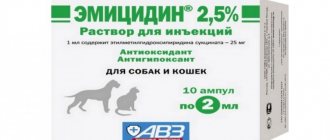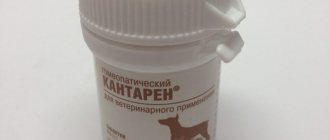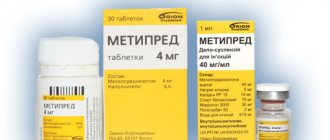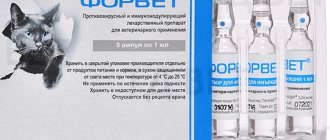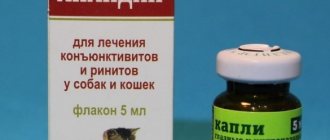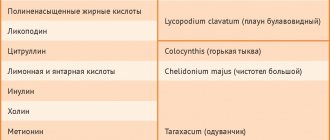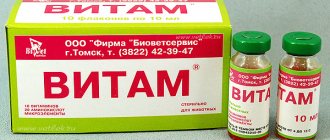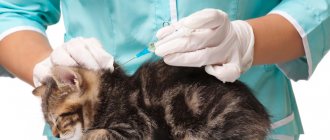7555Pavel
Prednisolone is a steroid hormone. It is used for a wide range of diseases in cats and dogs. Mistakes in the use of this product can cause serious harm. Therefore, in the case of treatment, clear instructions for using the drug Prednisolone are necessary. It is dangerous for cats in uncontrolled quantities and for an uncontrolled duration of use. This medication is prescribed for inflammatory diseases, allergies and stress. In addition, it is able to regulate glucose metabolism in the body.
Prednisolone, also known as Prednisone, is used to treat inflammation, nervous system disorders, malignant tumors, joint lesions, renal coma, dermatitis and tinea versicolor in cats. The list of diseases for which prednisolone helps is long.
© shutterstock
What is Prednisolone
Prednisolone is a synthetic glucocorticosteroid drug that helps eliminate the inflammatory process. Available in five varieties. The active ingredient for all dosage forms is prednisolone. The medicine has the following properties:
- reduces the intensity of pain;
- relieves swelling;
- eliminates acute allergic reactions;
- reduces symptoms of itching;
- reduces the number of rashes due to dermatitis;
- accelerates tissue healing;
- constricts blood vessels.
This medicine helps to cope with the shock that occurs with severe burns, injuries and anaphylactic reactions. In the treatment of cats, the drug is also used as an auxiliary method for the treatment of adrenal diseases. Sometimes Prednisolone even helps to save a pet’s life, for example, with progressive swelling of the larynx.
Prednisolone is a glucocorticosteroid medication
Attention! Glucocorticosteroid medications have a systemic effect on the body. Under no circumstances should you give them to your pet uncontrollably.
Characteristics of tablet form
The tablets are intended for oral administration. In addition to the active component, the composition includes:
- colloidal silicon dioxide;
- potato starch;
- stearic acid;
- magnesium stearate;
- talc;
- povidone;
- corn starch;
- lactose monohydrate.
The drug can be stored in tablet form for three years at a temperature not exceeding 25 degrees. If necessary, the medication can be kept in the refrigerator, but freezing should be avoided.
Prednisolone tablets are intended for oral administration
Attention! The tablets can be harmful if taken accidentally, so it is important to keep them away from children and animals.
Injection
The solution is intended for intravenous and intramuscular injections. Auxiliary components for this release form:
- nicotinamide;
- sodium metabisulfite;
- disodium edetate;
- sodium hydroxide;
- water d/i.
Prednisolone solution is intended for injection.
It is recommended to store the solution in a cool place or at room temperature not exceeding 25 degrees. The medication is valid for three years; after this period, this form cannot be used for treatment.
Composition and storage conditions of the ointment
Prednisolone in the form of ointment is one of the safest forms of release. In addition to the active substance, the medication contains:
- glycerol;
- petrolatum;
- stearic acid;
- emulsifier;
- methyl parahydroxybenzoate;
- propyl parahydroxybenzoate;
- purified water.
The shelf life of the ointment is the same as that of the solution. It is important to pay attention to the integrity of the packaging. If the protective membrane is opened, the drug cannot be used.
Prednisolone ointment is used externally only
The normal color of the ointment is white. If the shade turns yellow or some impurities appear in the composition, then it is possible that the storage conditions have been violated. This ointment cannot be used for treatment.
Eye drops and lyophilisate
Drops are used for ophthalmological diseases. In addition to prednisolone, the composition includes special-purpose water. The drops should be stored for no more than three years at a temperature not exceeding 25 degrees. These conditions do not apply to the opened bottle, which can be kept in the refrigerator and used for 4 weeks.
The lyophilisate contains prednisolone hemisuccinate in powder form intended for dilution and injection use. The drug in this form is stored under the same conditions as the solution.
Lyophilisate is rarely used to treat pets, since it requires preliminary dilution with water, which is not always convenient. Instead of this form, a regular injection solution is most often preferred.
When is medication prescribed - table
| Release form | Indications |
| Pills |
|
| Solution |
|
| Ointment |
|
| Eye drops |
|
| Lyophilisate |
|
Characteristic
The active ingredient is prednisolone sodium phosphate. This is a synthetic analogue of the hormone that is secreted in the body by the adrenal cortex - cortisone. In regular pharmacies you can buy the medicine in different forms:
- pills;
- ointment;
- eye drops;
- solution for injections.
In the form of injections, Prednisolone is used as an emergency aid in situations where there is a threat of death of the animal.
Operating principle
Prednisolone is able to suppress the activity of leukocytes, thereby reducing the intensity of the body's inflammatory response. This reduces the permeability of the vascular walls and the synthesis of prostaglandins - mediators that are responsible for the occurrence of pain. In addition, this glucocorticosteroid affects the production of histamine, the main provocateur of an allergic reaction.
Prednisolone is often used for allergies in cats of unknown cause.
The active component also increases blood glucose levels and is quickly absorbed by any method of application. In addition, this drug replenishes the deficiency of adrenal hormones. However, the drug not only has a positive effect, but can also provoke excessive production of hydrochloric acid, which contributes to the appearance of stomach ulcers.
Attention! Prednisolone can disrupt your pet's metabolism when used over a long period of time, promoting fat accumulation. In this case, the cat recovers quickly, but its appetite may remain unchanged.
Contraindications
Prednisolone is contraindicated in severe forms of hypertension, diabetes mellitus, in the presence of Itsenko-Cushing's disease, acute endocarditis, nephritis, gastric ulcer, osteoporosis and various types of psychoses.
It should also not be taken by pregnant women, the elderly and people suffering from stage 3 circulatory failure, as well as those who have recently undergone surgery, syphilis or active tuberculosis. In the presence of infectious diseases and tuberculosis, this medicine can be used simultaneously with antibiotics and anti-tuberculosis drugs.
Features of application
The treatment regimen depends on the specific pathology, since the drug can be used for long-term therapy, as well as as an emergency treatment. The veterinarian determines which release form to use after a series of studies and diagnosis.
Tablets: treatment regimen and dose
The dose is calculated based on the pet's weight. For 1 kg, 0.3–0.5 mg of the drug is provided. Tablets can be given mixed with food or forcibly 2 times a day for 14 days. The exact course is determined by the doctor depending on the nature of the pathology. In order for the pet not to notice the presence of the medicine in the food, the tablets must be thoroughly crushed. If this method is not suitable, then the drug can be placed on the root of the cat’s tongue or infused using a disposable syringe after preliminary crushing and mixing with water.
The easiest way is to give the tablet to your cat by first crushing it and mixing it into the food.
Attention! Before giving your pet a tablet, you should carefully secure it to avoid bites and scratches. To provoke the swallowing reflex, it is recommended to stroke the cat's neck immediately after manipulation.
How to give a cat a pill - video
How to use the solution and lyophilisate
The lyophilisate is used in the same way and in the same dose as the solution. The amount of the drug is calculated based on body weight. For 1 kg approximately 0.5 ml of medicine. The solution and lyophilisate are used for no more than 5 days. Prednisolone is administered to pets only intravenously in a veterinary clinic once a day. In this case, it is prohibited to give an injection yourself, since if the actions are performed incorrectly, undesirable reactions may occur.
Only a specialist should give an intravenous injection to a cat.
Most often, the solution and lyophilisate are used in emergency cases, for example, when a pet has been seriously injured. Intravenous administration of the medicine can alleviate the cat’s condition in just a matter of minutes.
Dosage and duration of treatment with ointment
The ointment is used mainly for allergic or atopic dermatitis. It is applied to the affected areas once a day for a period determined by the doctor. Often the course of treatment does not exceed 1 week. After applying the product, it is important to put a blanket or protective collar on the cat, thereby preventing the ointment from being licked off.
The blanket helps prevent licking of the ointment
Attention! If the cat has thick hair, then it must first be cut off in the area where you plan to apply the ointment. Otherwise, the product may not be absorbed well.
Our cat had an allergy of unknown cause. The veterinarian recommended trying to change the food, and also prescribed Prednisolone ointment, because the pet was constantly scratching and licking its belly. As a result, there was practically no wool left in this area. Prednisolone had to be used for a long time, the stomach gradually grew larger, but it was noticeable that the cat had gained several kilograms. Unfortunately, after stopping the medication, the allergy returned again.
How to use eye drops
Drops are used 1-2 times a day depending on the pathology. The course of treatment varies from 5 days to a week. One drop is provided for each eye. To do everything correctly, it is recommended to wrap your pet in a towel or blanket, and you should also ask someone to hold the cat's head.
The cat needs to instill the medicine 1-2 times a day.
If they get into inflamed eyes, the drops can cause pain, so the pet will actively resist. It is recommended to stroke your pet and talk to it as gently as possible in order to reduce stress.
How to put medicine in a cat's eyes - video
Can it be used to treat pregnant cats and kittens?
Glucocorticosteroid drugs cannot be used to treat pregnant and lactating cats, as such medications can cause dangerous consequences, including fetal death. Also, Prednisolone is not used to treat kittens. The drug can be used only from the first year of life.
The drug is not used to treat kittens.
Attention! Glucocorticosteroids penetrate the placental barrier and are also absorbed into breast milk, contributing to metabolic disorders in kittens.
Owner reviews
Svetlana, owner of a French bulldog:
“Our French woman lived on Prednisolone for three years. There was oncology and skin problems. In general, the dog tolerated the medication well, but towards the end of its life swelling and other problems began to appear. I think Cushing joined in, but overall I was satisfied with the use of the drug. He extended our dog’s life.”
Maria, owner of Labrador:
“Our dog has a chronic autoimmune disease, so we periodically take courses of Prednisolone. To avoid side effects from the digestive system, it was taken together with Kvamatel. Additionally, they took calcium supplements. No side effects were noticed, tests were taken regularly.”
Side effects and warnings
The following undesirable symptoms may occur during treatment with this medication:
- weight gain;
- heart rhythm disturbances;
- increased blood pressure;
- convulsions;
- headache;
- loss of coordination;
- damage to bone tissue;
- frequent urge to urinate;
- stomach ache.
In what cases is the drug not recommended for use:
- for heart diseases and inflammatory processes occurring in the gastrointestinal tract;
- when there are parasites in the pet’s body;
- if the cat suffers from endocrine disorders.
Short-term use of Prednisolone often does not cause serious side effects.
Medicines with similar effects - table
| Name | Release form | Active ingredient | Indications | Contraindications | Adverse reactions | Can it be used for therapy in pregnant cats? | Price |
| Hydrocortisone |
| hydrocortisone | Acute allergic reactions and inflammatory processes, including autoimmune ones. |
|
| No. | From 132 rub. |
| Dexamethasone |
| dexamethasone | Allergic reactions, inflammatory diseases of connective tissue and skin, as well as various types of dermatitis. |
|
| No. | From 60 rub. |
| Dexafort | Suspension | dexamethasone | Inflammatory pathologies and autoimmune diseases of various etiologies. |
|
| No. | From 1000 rub. |
Drugs similar in principle of action - photo gallery
Dexafort is intended specifically for the treatment of animals
Dexamethasone can cause high blood pressure
Hydrocortisone is one of the powerful glucocorticosteroids
Prednisolone is a complex action drug that allows you to quickly get rid of a number of severe symptoms. The medication, in addition to its positive effect on the body, has a lot of contraindications and side effects. If you use such a remedy in the correct dosage, you can achieve a quick positive result from therapy.
Purpose
Most often, Prednisolone is used as an effective antiallergic agent, but its scope of action is much wider, so the hormonal drug is used for therapy:
- acute viral diseases;
- skin lesions;
- pathologies of the immune system;
- chronic adrenal insufficiency (in which cortisone is not produced by the animal’s body or is produced in insufficient quantities);
- bilateral recurrent inflammation of the eyelids and inflammation of the eye mucosa;
- malignant neoplasms and other pathologies.
